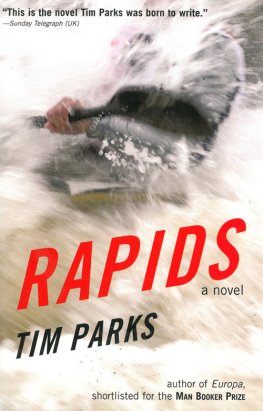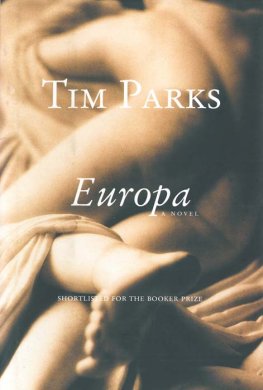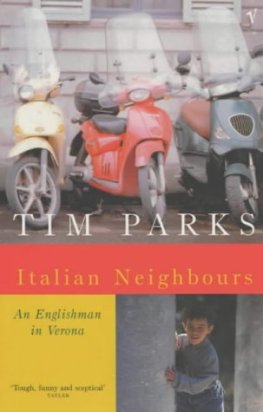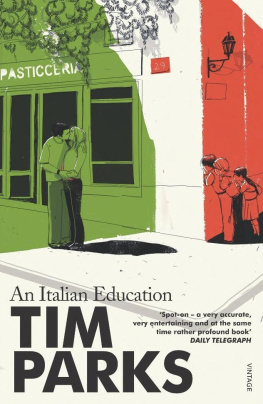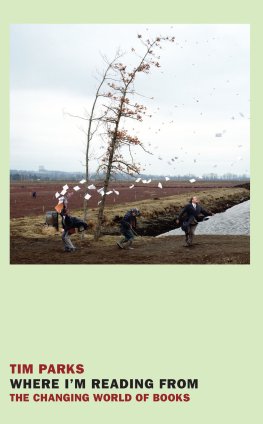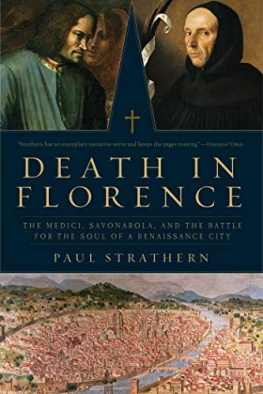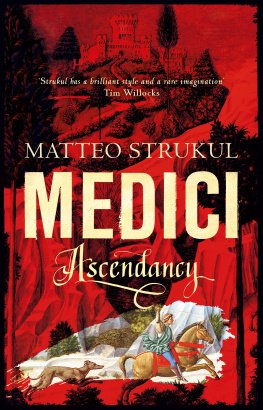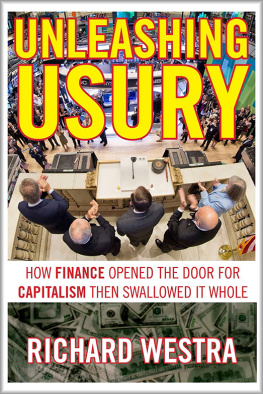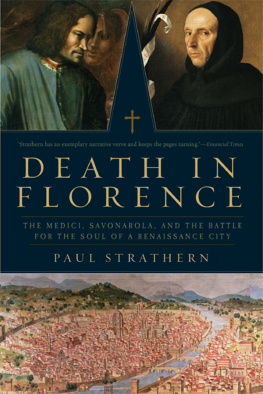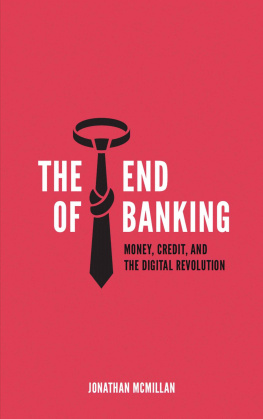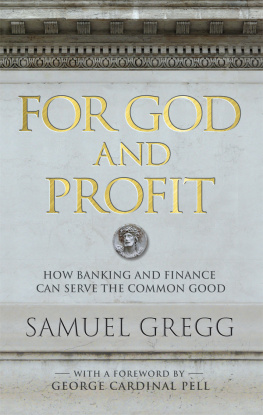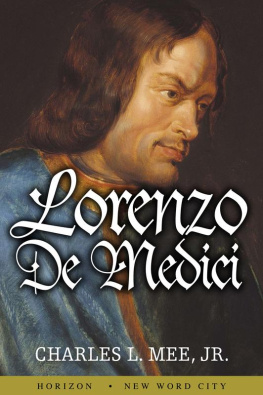Tim Parks
Medici Money: Banking, metaphysics and art in fifteenth-century Florence

1348
The plague kills more than a third of the population of Florence
1378
The revolt of the ciompi (woolworkers rebellion)
1389
Birth of Cosimo de Medici
1397
Cosimos father, Giovanni di Bicci, founds the Medici bank in Florence with a branch in Rome
1400
Branch of the Medici bank opens in Naples
1402
Branch of the Medici bank opens in Venice A Medici wool factory opens in Florence
1406
Florence conquers Pisa
1408
A second Medici wool factory opens in Florence
1410
Baldassarre Cossa elected Pope Giovanni XXIII
1416
Birth of Piero de Medici (the Gouty)
1420
Death of Baldassarre Cossa; his tomb is commissioned by Cosimo de Medici
Giovanni di Bicci retires, leaving the bank to his son Cosimo
1424
Milanese army routs the Florentines at Zagonara
1426
Branch of the Medici bank opens in Geneva, later transferred to Lyon
1427
Introduction of the catasto, a form of direct taxation
1429
Death of Giovanni di Bicci
War with Milan over Lucca
1433
Branch of the Medici bank opens in Basle
Medici silk factory opens in Florence
September 7, Cosimo de Medici arrested and exiled
1434
September 29, Cosimo recalled to Florence
1435
Giovanni Benci becomes director of the Medici holding
1436
Branch of the Medici bank opens in Ancona
Dome of the Florence Duomo completed
143643
Restoration of the Monastery of San Marco financed and directed by Cosimo de Medici
1437
Christians in Florence banned from all moneylending practices
1438
Ecumenical conference between leaders of the Byzantine and Roman churches, in Florence
1439
Branch of the Medici bank opens in Bruges
1440
Death of Cosimos brother, Lorenzo
1442
Branch of the Medici bank opens in Pisa
1443
Closure of the Ancona and Basle branches of the Medici bank
1446
Branches of the Medici bank open in Avignon and London
1449
Birth of Lorenzo de Medici (the Magnificent)
1450
Francesco Sforza conquers Milan with the help of Cosimo de Medici
1452
Branch of the Medici bank opens in Milan
1453
Fall of Constantinople
1455
Giovanni Benci, director of the Medici holding, dies and the holding is wound up
1458
Government crisis leads to calling of a parlamento and reinforcement of Medici power
1464
Death of Cosimo
Giovanni Tornabuoni becomes director of the Rome branch of the Medici bank
1465
Tommaso Portinari becomes director of the Bruges branch of the Medici bank
Closure of one Medici wool factory
1466
Piero de Medici calls a parlamento and again consolidates Medici power; his son Lorenzo signs a deal with Pope Paul II that gives the bank a monopoly in the alum trade
1469
Death of Piero; his son Lorenzo marries the nobleborn Clarice Orsini; Francesco Sassetti becomes sole director of the Medici bank
1471
Florentine army sacks Volterra
1472
Birth of Piero de Medici (the Fatuous)
1476
Assassination of Galeazzo Maria Sforza, duke of Milan, major client of the Medici bank
1477
Death in battle of Charles, duke of Burgundy (le Tmraire), major client of the Medici bank
1478
The conspiracy of the Pazzi. Giuliano de Medici, Lorenzos younger brother, assassinated; Lorenzo survives; war with Rome and Naples ensues
Closure of the Milan and Avignon branches of the Medici bank
1479
December, Lorenzo goes alone to Naples to negotiate a peace with King Ferrante
1480
Turks raid Otranto on the southeast coast of Italy and take 10,000 people as slaves
Closure of the Bruges and London branches of the Medici bank and of the Medici silk factory
1481
Closure of the Venice branch of the Medici bank
1485
Lionetto de Rossi, head of the Lyon branch of the bank, recalled to Florence and arrested for fraudulent bankruptcy
1489
Closure of the Pisa branch of the Medici bank
Lorenzos second son, Giovanni di Lorenzo de Medici, later Pope Leo X, becomes a cardinal at the age of thirteen
1490
Death of Francesco Sassetti
Savonarola begins his sermons on the apocalypse in the Monastery of San Marco
1492
Death of Lorenzo de Medici (the Magnificent)
1494
French invasion; flight of Piero de Medici (the Fatuous) and collapse of the bank
With usura,
wrote Ezra Pound,
hath no man a house of good stone
each block cut smooth and well fitting
that design might cover their face.
By usura, Pound meant usury, or the lending of money at an interest. Not just an exorbitantly high rate of interest, as in the modern usage of the word usury, but any interest at all. He goes on:
with usura
hath no man a painted paradise on his church wall.
no picture is made to endure nor to live with
but it is made to sell and sell quickly
with usura, sin against nature.
In the 1920s Pound had come to believe, as many still do, that international banking was a source of great evil. He used the Italian word usura because it was in Italy that the story had begun. During the thirteenth and fourteenth centuries, a web of credit was spun out across Europe, northward to London, east as far as Constantinople, west to Barcelona, south to Naples and Cyprus. At the heart of this dark web of usura lay Florence. But in the same period, and above all in the century that followed, the Tuscan city also produced some of the finest painting and architecture the world has ever seen. Never had stone blocks been cut more smoothly, never were finer paradises painted on church walls. In the Medici family in particular, the two phenomena modern banking, matchless art were intimately linked and even mutually sustaining. Pound, it seems, got it wrong. With usura we have the Renaissance, no less.
This book is a brief reflection on the Medici of the fifteenth century their bank; their politics; their marriages, slaves, and mistresses; the conspiracies they survived; the houses they built and the artists they patronized. The attempt throughout will be to suggest how much their story has to tell us about the way we experience the relationship between high culture and credit cards today, how far it informs our continuing suspicions with regard to international finance and its dealings with religion and politics.
The story is complicated. There are five generations to consider. Its important to get the main names and dates and the overall trajectory of the thing firmly in the head from the start.
The bank is founded in 1397 and collapses in 1494. Alas, there will be no centenary party. Giovanni di Bicci de Medici starts it. That is: Giovanni, son of Bicci (inexplicable nickname for Averardo), of the Medici family. Born in 1360, Giovanni is responsible for the banks initial expansion and for establishing a particular Medici style. He keeps his head sensibly down among his flourishing account books before departing this life in 1429. Stay out of the public eye, he tells his children on his deathbed.
Cosimo di Giovanni de Medici eventually disobeys that order, which is why he will later be reverently known as Cosimo


